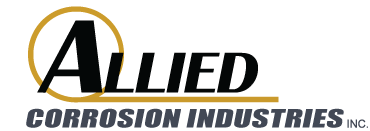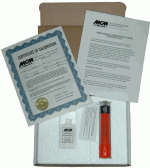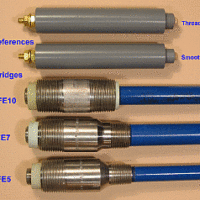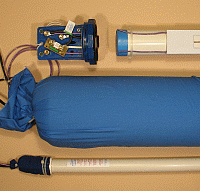Portable Reference Electrodes
Portable and Immersion Reference Electrodes
This category contains portable reference electrodes (half cells) as well as two immersion reference electrodes. Both immersion reference electrodes are suitable for complete immersion. Model IR is to be used in water tanks, waterfront structures and other applications while the Model IP is designed for immersion in seawater.
Portable Reference Electrodes from EDI
Description
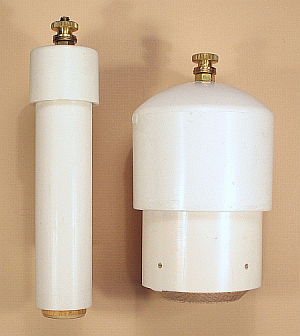
EDI’s permanent portable reference electrode, Model IT, is used to take potential readings in any application where a standard, liquid-junction portable reference electrode is presently being used. Because the Model IT contains a gel rather than a liquid, it can be used in all positions. Since it does not require refilling or cleaning, it will provide long maintenance-free service. The hardwood plug offers several advantages over ceramic membranes: it will not clog as readily, it is resistant to salt blockage, and it can be reworked by light sanding or cutting if it becomes contaminated with oil. This electrode can be ordered with antifreeze added to the gel (optional) so that the electrode will not be damaged if exposed to temperatures down to -30°F (-34°C). However, antifreeze may shift the reference potential by up to 12 mV.
The Model IT portable reference electrode has a twenty year design life and an indefinite shelf life if the end cap is in place. It is available in two styles: Model IT2 is for general use while Model IT3 is designed to be free-standing. Either model may be ordered with a gelled copper/copper sulfate (CUG) element or a gelled silver/silver chloride (AGG) element. Refer to the menu below for additional information on these elements. Both models have a 1/4 – 20 threaded stud termination.
For More Information
Complete Product Information and Installation Instructions are available for downloading as pdf files. Click on the link below to download.
Permanent Portable Reference Electrode (Model IT data sheet.)
Element Selection Guide
EDI portable reference electrodes may be ordered with any of five different reference elements. The element selected depends upon the electrolyte in which the electrode is used.
Gelled copper/copper sulfate elements (EDI code CUG) are typically used in environments with less than 500 ppm chloride or other halides. They consist of high purity metallic copper immersed in a saturated CuSO4 solution containing a gelling agent. Use of these elements in electrolytes with higher halide levels or in electrolytes with any sulfides present will contaminate the element causing its reference potential to drift. Because of their widespread use, Cu/CuSO4 electrodes are the ones upon which many cathodic protection criteria are based. Cu/CuSO4 elements are available in all EDI product groups except Concrete Products.
Gelled silver/silver chloride elements (EDI code AGG) can be used in any environment which does not contain sulfides. They consist of 99.99% pure silver coated with silver chloride and immersed in a saturated potassium chloride solution containing a gelling agent. The reference potential of Ag/AgCl/sat. KCl elements is 105 mV positive to that of a saturated Cu/CuSO4 reference electrode. Ag/AgCl/sat. KCl elements are available in all EDI product groups.
Dry silver/silver chloride elements (EDI code AGD) are most commonly used in clean full strength seawater where the electrolyte comes into direct contact with the element. Like the gelled Ag/AgCl elements, they are adversely affected by sulfides. The reference potential of dry Ag/AgCl elements immersed in full strength seawater is 70 mV positive to that of a saturated Cu/CuSO4 reference electrode. As the ambient chloride level decreases, as would be the case when used in brackish water, the reference potential becomes less positive. Dry Ag/AgCl elements are only available in our through-wall, immersion and tubesheet mounted reference electrodes.
Dry silver/silver chloride elements for concrete (EDI code AGC) is a variation of our standard dry Ag/AgCl element which has been adapted for encasement in a cement-based grout. The reference potential depends on the pore water chloride level of the concrete structure in which it is embedded. This element is only available in our Marine Concrete reference electrode, EDI Model CM-AGC.
Zinc elements (EDI code ZIN) consist of high purity metallic zinc rod. When these elements are used in our underground reference electrodes, the zinc element is encased in a gypsum-bentonite backfill. The zinc element is directly wetted by the electrolyte in our through-wall and immersion reference groups. Reference potential of a zinc element encapsulated in backfill is about 1,100 mV negative to that of a saturated Cu/CuSO4 reference electrode. The reference potential of zinc directly exposed to an electrolyte depends on the composition of the electrolyte.
Portable Reference Electrodes
Portable Reference Electrodes

Additional information
Other Similar Products
Related products
-
- M.C. Miller, Reference Electrodes, Cathodic Protection
IonX Portable Electrodes
- $0.00
- Add To Quote This product has multiple variants. The options may be chosen on the product page
-
- M.C. Miller, Reference Electrodes, Cathodic Protection
Standard Silver Chloride Electrode Kits
- $0.00
- Add To Quote This product has multiple variants. The options may be chosen on the product page
